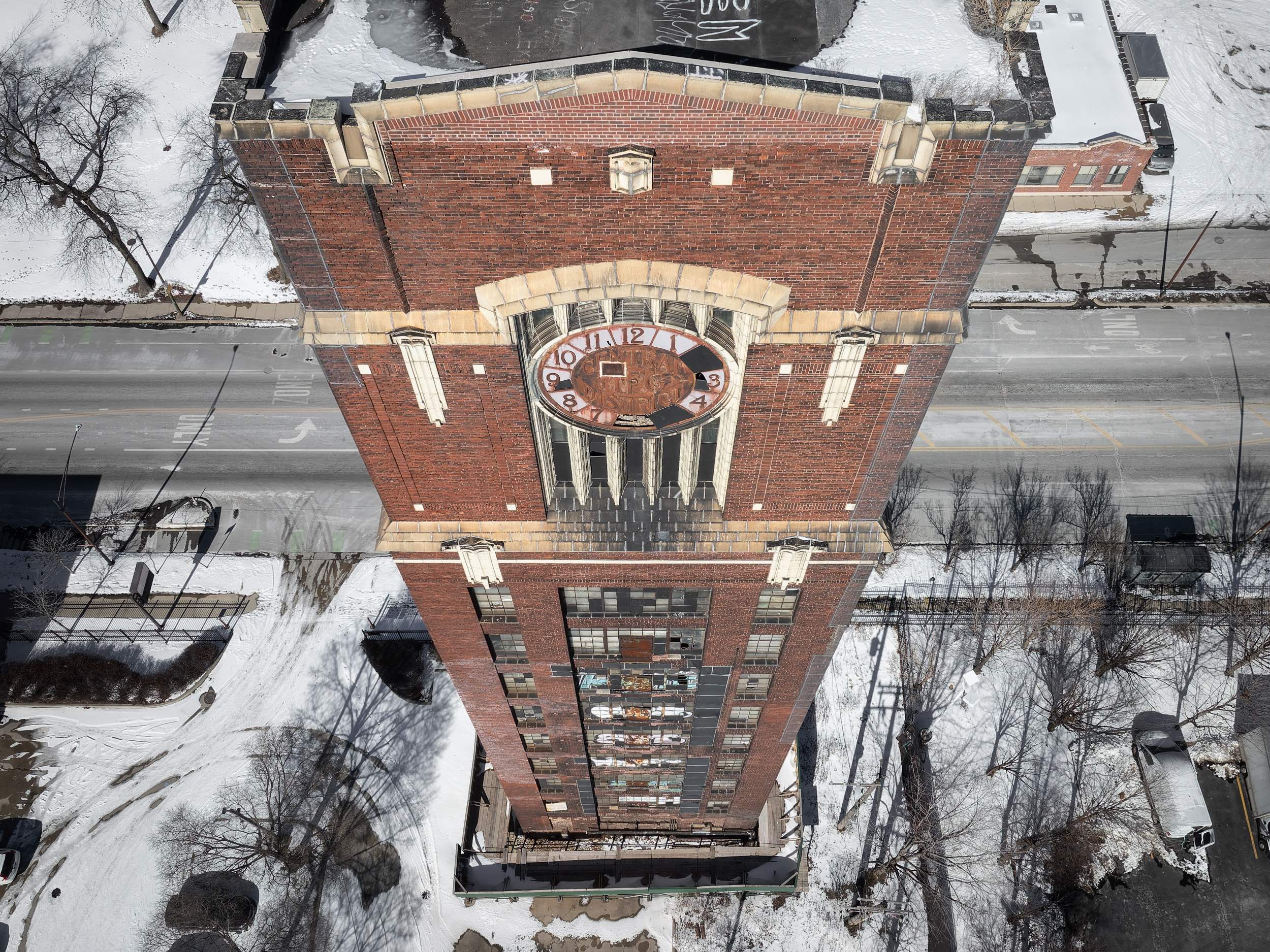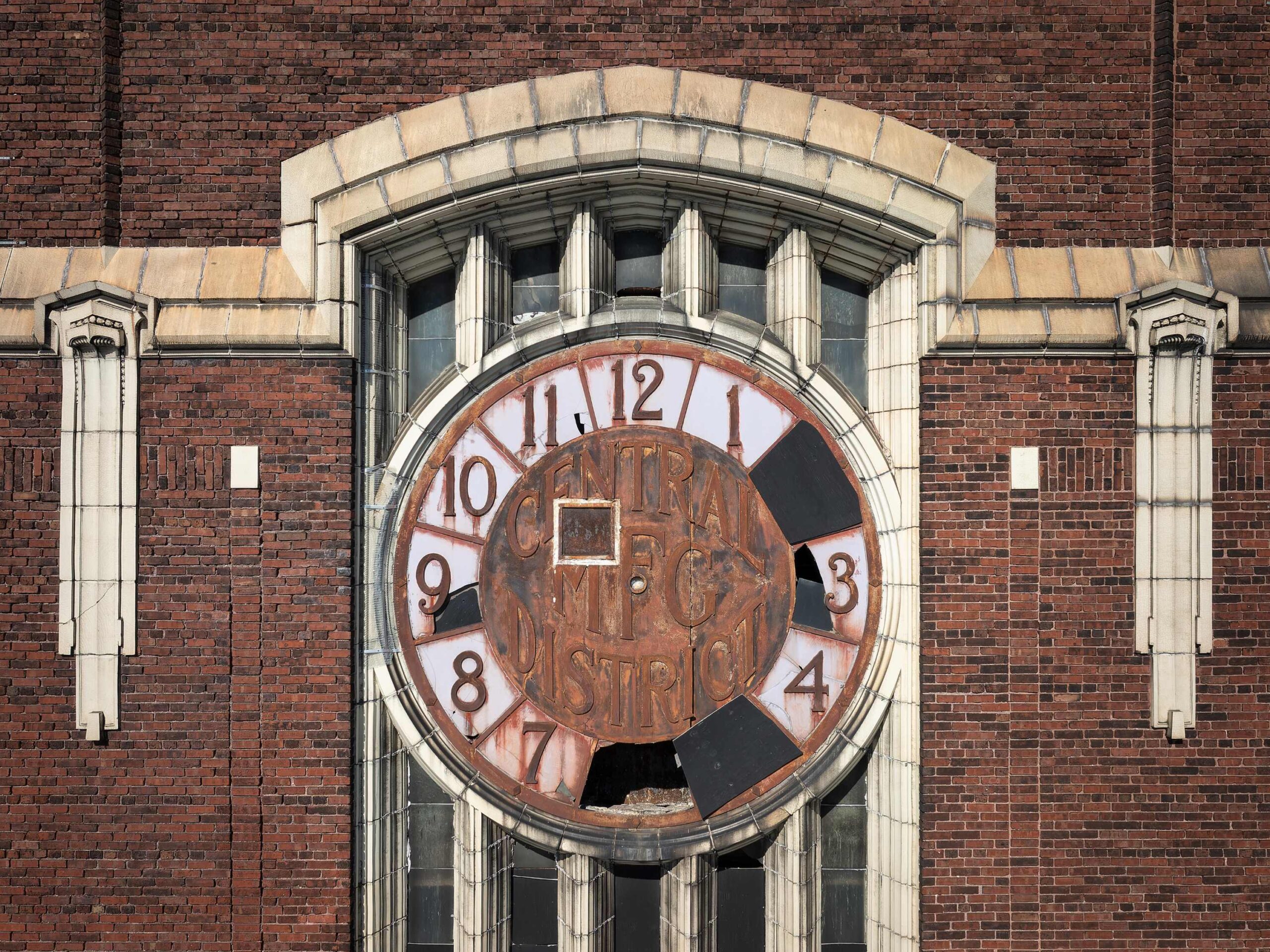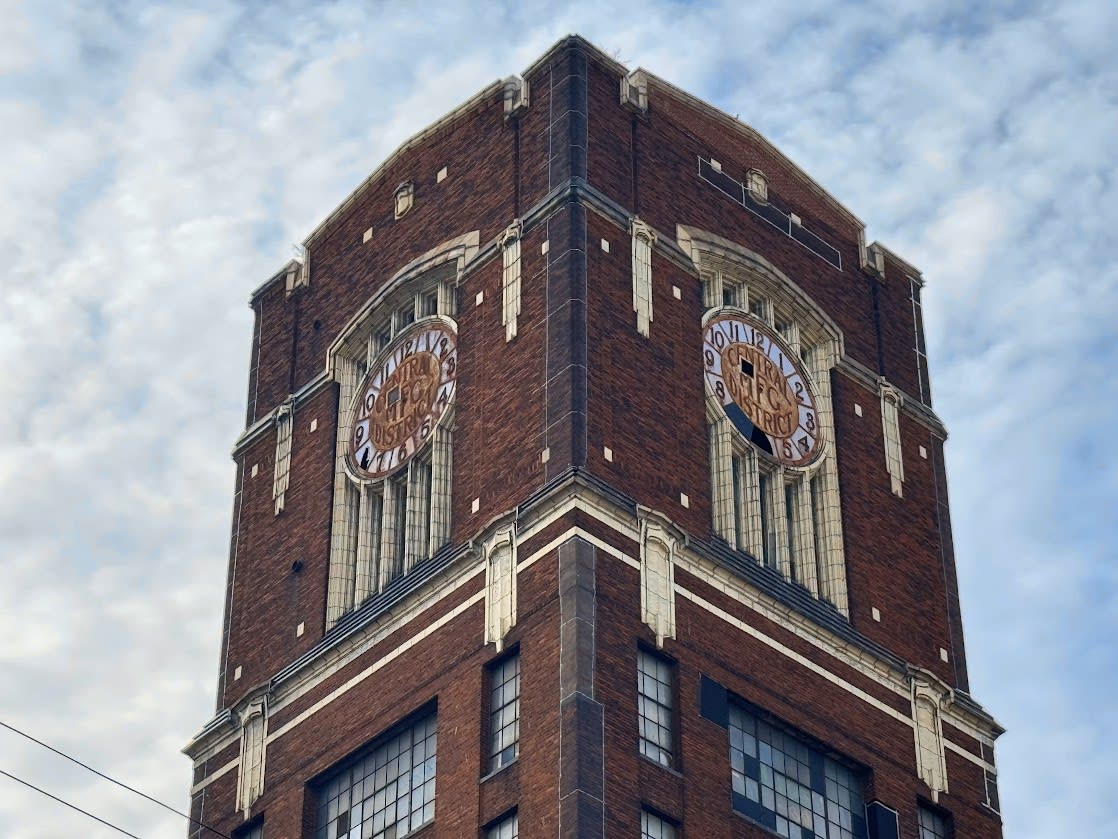











Central Manufacturing District Clock Tower
Address: 2000 W. Pershing Road
Architect: Samuel Scott Joy
Date: 1917
Style: Late Gothic Revival/Industrial Gothic
Neighborhood: McKinley Park
Overview
The Central Manufacturing District (CMD) Clock Tower Building located at 2000 W. Pershing Road, is a prominent structure which is positioned in the center of the CMD Pershing Road Development. The tall, slender, 11-story red-brick masonry and terracotta clad structure, the tallest in the CMD development, is symmetrical in form on each of its elevations, with large windows puncturing the masonry of the tower, and crowned at its upper most floors with four elaborate clocks on each of its facades. The structure was designed by architect Samuel Scott Joy, also responsible for many of the other massive buildings of the CMD. The building functioned as a water tower while also concealing a large water tank which provided a centralized fire suppression system for the entire CMD complex. The water tank with its water suppression system, was cleverly hidden within this large timepiece, which also continues to serve as a striking visual feature and landmark for this massive development, as well as the McKinley Park Community.
Preservation Chicago has previously listed the historic CMD as part of our Chicago 7 Most Endangered List in the past, noting the deteriorating conditions and vacancy of several of these massive and beautifully-crafted structures. The CMD Pershing Road Development was included on our 2014 and 2020 lists, and the CMD Original East was included on our 2021 list. Both the historic CMD Original East District and the CMD Pershing Road Development are historic districts listed in the National Register of Historic Places (NRHP). The Clock Tower Building is a contributing resource to the CMD Pershing Road Development. It is also a contributing resource to another National Register-listed historic district, the Chicago Park Boulevard System Historic District, given its proximity and visual relationship with McKinley Park, just opposite the building along West Pershing Road. Over the past decade, Preservation Chicago has also suggested the clock tower and CMD complex be considered for Chicago Landmark Designation.
History
The Central Manufacturing District was the first planned industrial district in the nation which experimented in large-scale land development, capitalized on new technologies in construction and power production, and became the national model for the post-World War II industrial park. The first buildings in the Original East District were constructed in 1902. Construction began along the Pershing Road Development in 1917. The area was ideal for its large tracts of available and inexpensive land with access to railroads and proximity to a large, working-class population. Rail line spurs connected the main tracks to each building, allowing for more efficient shipping and transportation of goods.
The CMD was originally envisioned in response to economic and geographic pressures in the city’s Central Business District and to enhance business opportunities along Chicago’s flourishing network of national rail lines. Frederick Henry Prince, a New England-based financier with investments in stockyards, was instrumental in developing the CMD concept. Within ten years’ time, more than 200 firms were operating within its boundaries. The early years of the CMD were so successful that Prince expanded the development west on Pershing Road.
Fire protection was a serious concern throughout the city but especially within this manufacturing district. Most, if not all, of the buildings were sprinklered, and the layout of the district provided safe distances between adjoining structures. The District also planned and built private water lines throughout the CMD, with special equipment to facilitate city fire engines’ ability to access water in the event of a fire. An official from the Board of Fire Underwriters stated that the buildings comprising the CMD are “the best group of manufacturing buildings constructed from the fire insurance standpoint in the City of Chicago.”
The Pershing Road Development is anchored by the beautiful 11-story Clock Tower Building, also called the Water Tower, designed by Samuel Scott Joy, which measures 50 feet wide and 38 feet deep. The tower features four clock faces, one on each facade, which are emblazoned with the “Central Manufacturing District” seal. The tower is surrounded by a series of tall, reinforced-concrete buildings that are sheathed in similar red brick, stone, and terracotta elements. The tower was built in 1917 by Butler Street Foundry & Iron, a company that provided structural and architectural steel and iron work. The structure is an example of a “disguised” or “concealed” utility structure within an architectural language that is more “artistically designed.”
On December 1, 1926, Water Works Engineering magazine reported that “the architects have found a means for concealing the naked ugliness of the too prominent water tanks” and cited the CMD Pershing Road Development Clock Tower Building as a prime example:
“A stately tower of very good proportions not only serves as an office building but also contains two Horton elliptical bottom tanks mounted one above the other – the combined capacity is 250,000 gallons. The bottom of the lower tank is 118 feet above the ground and the bottom of the higher tank is twenty-four feet above this. The tower is supported on an eight post steel tower which extends down to just above the eighth floor.”
The fire protective function of the tower is effectively wrapped in office spaces and concealed behind architectural expression. Betsy H. Bradley, author of The Works: The Industrial Architecture of the United States, described the structure as “an empathetic synthesis of centralized power and fire protection.” The lower level offices housed the industrial district’s architecture department and construction staff. For Bradley, the electrically illuminated clock faces “served as an ever visible reminder of the need for fire safety.”
The industrial buildings throughout the CMD Pershing Road Development share a unity of scale, volume, design and various detailed features, but the Clock Tower Building remains the tallest, most visible beacon of industrial development and heritage in the neighborhood.
Threat
Like many of the buildings throughout the CMD Pershing Road Development, the Clock Tower Building remains underutilized and vacant, and has laid in this state for decades. The building is in a significant state of deterioration and only the minimum necessary stabilization and safety measures are being undertaken. Increasing areas of containment netting have been installed throughout all four of the building’s facades and protective scaffolding surrounding the base of the building has been in place for over a decade to protect passers-by from the potential of deteriorated and falling masonry and terracotta elements.
Without proper mothballing and stabilization measures put in place until a new preservation-sensitive owner comes along, the building will likely continue to deteriorate, ultimately increasing the threat of demolition by neglect. Other buildings throughout the CMD have likewise been lost to the promise of new development, such as the Continental Can Company Building (previously listed on our Most Endangered list in 2020, 2021, and 2023), which was demolished in 2024.
Since the CMD Pershing Road Development was listed on our Chicago 7 Most Endangered List in 2020, the Clock Tower Building and three warehouses, including all adjoining land, were unsuccessfully listed for sale for $12 million by property owner and manager Imperial Realty Company. According to the company’s website, the “Clock Tower Industrial Center,” which includes the Clock Tower Building, is still under their ownership and management as of early 2025. The real estate listing presented the property as a “multi-family redevelopment opportunity.”
Recommendations
As a contributing resource to a National Register-Listed historic district, the CMD Clock Tower Building is a certified historic structure. A qualified rehabilitation or adaptive reuse project could utilize both State (IL) and Federal (F) Historic Tax Credits (HTCs) for project financing. Under the IL-HTC program, project sponsors can receive a state income tax credit equal to 25% of qualified expenses (capped at $3 million). Under the F-HTC program, project sponsors can receive a federal income tax credit equal to 20% of qualified expenses (no cap). By stacking both HTC programs, owners can benefit from up to 45% of rehabilitation project costs returned in the form of tax credits.
As an Orange-rated property in the CHRS, the Clock Tower Building is also protected by the 90-Day Demolition Delay Ordinance adopted in 2003. However, Preservation Chicago recommends and continues to advocate for the designation of this significant building as either an individual City of Chicago Landmark or as part of a larger Landmark District. Formal landmarking would best safeguard the clock tower and adjacent district buildings from future demolition threats or insensitive alterations.
The CMD Clock Tower, and the entire CMD Pershing Road Development, is a defining element of the McKinley Park/New City community that meets multiple criteria for local landmark designation. This status would incentivize preservation and investment in this important component of Chicago’s industrial history and provide more community control over the building and the area’s future rehabilitation and development. For years, the McKinley Park community has voiced its support for the preservation of the Clock Tower Building and the entire CMD Pershing Road Development, which are seen as neighborhood assets. A preservation-sensitive buyer committed to continued office or mixed adaptive reuse can make that vision a reality


